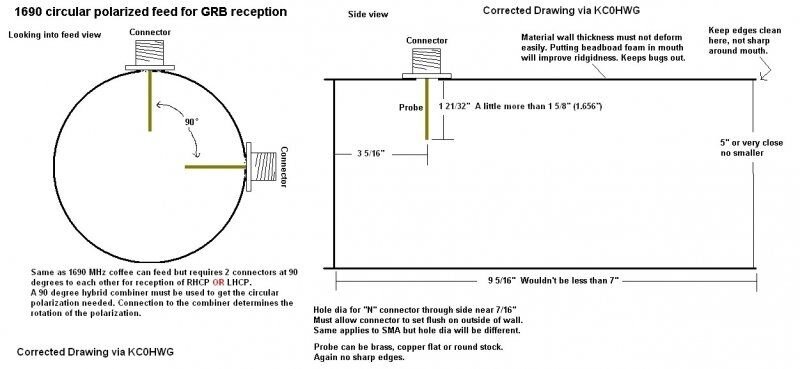Brett,
I just tested my septum feed and it don't work. I can't get a lock even though the signal looks great on the SDR spectrum. It's even a 2-3 dB (-107 dBm) more then what I get with the 2 probe method but it won't lock on either polarization. It will only show a lock for a sec or 2.
The reason for this in my thought is...
1. There could be a linearity to the feed receiving this dual polarization transmission. You mentioned this as stating it could receive linear polarization as well.
If it can receive liner polarization then it would be 3 dB down due to the antenna used. In my test I'm not seeing a 3 dB signal difference.
2. Due to the dual polarization nature of the transmission it could be cross talking between the two resulting in contamination of the received signal wanted.
Since we have both built these one of us should be able to get a semi solid lock on the signal but we can't. So this out rules design flaws as an issue here.
Ever since I built my dual probe feed I have never had any issues getting a signal lock on the DVBS-2 outer layer with the S300. Eventhough I can't process the data layer.
It's possible that this feed may need a bigger dish if it's splitting the signal between the 2 (but I don't know). In any case this won't be doable so we know what works. This is why I held back posting any info on this feed as I didn't know if it was going to work for this purpose.
I consider this a failed test, and will use the 2 probe method for reception of GRB. The 2 probe method will receive 1 polarization of the GRB stream.
What I did learn and gained was using a little larger choke ring does seem to improve the signal.
The current choke ring used is 12" dia X 3 3/8" deep and 1/4" back from the mouth of the feed.
The new choke ring will be 13" dia X 2 5/16" deep (2.32") and 1/4" back for the mouth of the feed.
The measurement is from the outer edge of the choke ring to feed mouth.
The feed I have been using for this is posted below. The dimensions are corrected and proper in this posting.

The simple way to combine the 2 probes is use a 90 degree signal combiner (part
Minicircuits ZX10Q-2-25) use a terminator cap and you're done. A cost of around $35-$40 in all. Again use 2 equal lengths of coax to the combiner. Connect the preamp after the combiner and filer if desired (amp again if filter is used) then down the line to the receiver.
Now for the other bit of news.
I finally got ahold of Ayecka. I used their direct email contact. I have been talking with them and will have some more info up here of the outcome of that.
I do have a question though.
Brett, does weather01089 have the SR1-GSE model, can you find out please?




 an hour to lock?
an hour to lock? I would be unglued for a receiver to take that long to lock.
I would be unglued for a receiver to take that long to lock. , I said when I started this forum that the DVBS-2 format has made reception of this data possible at a much cheaper cost. It's just how you want to do it. No all receivers are equal as the firmware and electronics make them very different.
, I said when I started this forum that the DVBS-2 format has made reception of this data possible at a much cheaper cost. It's just how you want to do it. No all receivers are equal as the firmware and electronics make them very different.
 Welcome to the world of High Resolution Weather Satellite Data.
Welcome to the world of High Resolution Weather Satellite Data. 